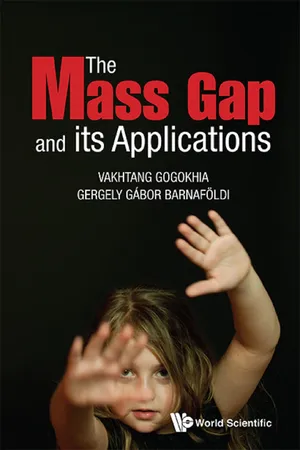
- 252 pages
- English
- ePUB (mobile friendly)
- Available on iOS & Android
Mass Gap And Its Applications, The
About This Book
Quantum Chromodynamics (QCD) is the most up-to-date theory of the strong interaction. Its predictions have been verified experimentally, and it is a cornerstone of the Standard Model of particle physics. However, standard perturbative procedures fail if applied to low-energy QCD. Even the discovery of the Higgs Boson will not solve the problem of masses originating from the non-perturbative behavior of QCD.
This book presents a new method, the introduction of the ‘mass gap’, first suggested by Arthur Jaffe and Edward Witten at the turn of the millennium. It attempts to show that, to explain the mass-spectrum of QCD, one needs the mass scale parameter (the mass gap) instead of other massive particles. The energy difference between the lowest order and the vacuum state in Yang–Mills quantum field theory, the mass gap is in principle responsible for the large-scale structure of the QCD ground state, and thus also for its non-perturbative phenomena at low energies. This book not only presents the mass gap, but also details the applications and outlook of the mass gap method. A detailed summary of references and problems are included as well.
This book is best for scientists and highly advanced students interested in non-perturbative effects and methods in QCD.
Contents:
- Theory of the Mass Gap:
- Quantum Chromodynamics and the Mass Gap
- Color Gauge Invariance and the Origin of the Mass Gap
- Formal Exact Solutions for the Full Gluon Propagator at Non-zero Mass Gap
- Renormalization of the Mass Gap
- General Discussion
- Applications of the Mass Gap:
- Vacuum Energy Density in the Quantum Yang–Mills Theory
- The Non-perturbative Analytical Equation of State for the Gluon Matter I
- The Non-perturbative Analytical Equation of State for the Gluon Matter II
- The Non-perturbative Analytical Equation of State for SU (3) Gluon Plasma
Readership: Scientists and very advanced students of Quantum Chromodynamics (QCD).
Frequently asked questions
Information











Table of contents
- Cover
- Halftitle
- Title
- Copyright
- Dedication
- Preface
- Acknowledgment
- Contents
- Theory of the Mass Gap
- 1. Quantum Chromodynamics and the Mass Gap
- 2. Color Gauge Invariance and the Origin of the Mass Gap
- 2.A Appendix: Application for Abelian case
- 3. Formal Exact Solutions for the Full Gluon Propagator at Non-zero Mass Gap
- 3.A Appendix: The dimensional regularization method in the perturbation theory
- 3.B Appendix: The dimensional regularization method in the distribution theory
- 4. Renormalization of the Mass Gap
- 4.A Appendix: The Weierstrass – Sokhatsky – Casorati theorem
- 5. General Discussion
- Applications of the Mass Gap
- 6. Vacuum Energy Density in the Quantum Yang – Mills Theory
- 6.A Appendix: The general role of ghosts
- 7. The Non-perturbative Analytical Equation of State forthe Gluon Matter I
- 7.A Appendix: The summation of the thermal logarithms
- 8. The Non-perturbative Analytical Equation of State forthe Gluon Matter II
- 9. The Non-perturbative Analytical Equation of State for SU(3) Gluon Plasma
- 9.A Appendix: Analytical and numerical evaluation of the latent heat
- 9.B Appendix: The β-function for the confining effective charge at non-zero temperature
- 9.C Appendix: Least Mean Squares method and the definition of the average deviation
- 9.D Appendix: Restoration of the lattice pressure below 0.9Tc
- Bibliography
- Index